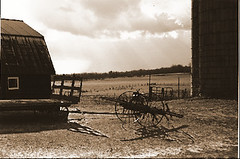The Distantial Storytelling of Fellini's Amarcord (1974)
More distantial from the eye. -- W. Montagu
If editing is the act of storytelling through the careful control of audience attention, then Amarcord might be considered a quixotic example of separating the audience from the story through a "pushing back" of the narrative. Cutting techniques create a staccato sense of interaction in this isolated seaside village in Mussolini's Italy, both through overlapping dialogue and the tumbling of action upon action which the sound augments and enhances. While the story itself takes a long time to build and each frame depends upon the last, the film often feels like the movement hovers indecisively between motionless dreamscape and acceleration threatening to derail the entire train. The disorienting effect of the editing allows the audience to glimpse a village caught somewhere between antiquity and modernity in a naive, highly impressionable state and serves the film's greater purpose. It should be noted that the title means "I remember," but these memories are not those of the audience any more than this country's history can be claimed by many of the film's viewers.
While it might seem an odd choice to paint the people of a country going through a sweep of fascism as naive and vulgar and laughably gullible by turns, the approach has the steely ring of honesty; and so, Fellini does not shy away from depicting an Italy star-struck by Hollywood and crumbling at its core between external political pressures and perplexing internal religious demands. Perhaps in an attempt to uphold the old saying that a country is never greater than the spirit of its people, Fellini uses the editing to allow each character as much realism and depth as possible while capturing the folly and peculiarities such a society would have bred and fostered, like the confusion concerning sexual matters. He does this so well, in fact, that it can become nearly impossible to see the Italian people of this time period in any way differently from these characters whose civilization threatens to topple the last vestiges of their innocence and uniqueness. Like any encroaching kingdom, fascism and Hollywood become villains; or, at the very least, partners in crime as the attraction to the powerful El Duce by the town's most eligible single woman can easily be viewed in tandem to her fascination with the screen -- or, perhaps, with Gary Cooper.
It comes as little surprise that despite the vignettes, Amarcord focuses on one family in general and its elder son in particular. The film needed some glue between its audience and its subjects, not only to convey a theme of universality that nearly anyone could relate to, but to root its distantial perspective within a family not overly given to sentimentality. Although an audience member can sympathize with the members of this family, the events and manner of their presentation doesn't allow for too great an attachment to any one thing, place or event. Their interrelationships so small amid the ruins of a once-great civilization now under Hitler's boring German thumb, they are essentially mere shadows of themselves. Both parents fight and exhibit so many childish qualities that marital harmony seems impossible in such a society, and the only thing certain is the knocking of the undertaker. These quibbles pebble the action without defining it, though; the main focus still remains on the son who is the future of the family and the country and, quite possibly, the equally anonymous "I" in "I Remember."
In light of the connection between the camera's focus and the antics of a young man, it could be further suggested that the film doesn't merely convey spatial realtions to keep the audience at a distance but to convey a sense of futility. Looking at the filmic movement toward separation and away from togetherness, especially in the scene introducing the family's Mad Hatter, what Fellini appears to be saying is that closeness (i.e., happiness) under the circumstances was nearly impossible. Our first knowledge of Uncle Teo begins with a rough cut from the Grand Hotel's silhouette (where the town's peddler and yarn-spinner Biscein supposedly once had intercourse with 28 concubines) and the film's recurring, romantic theme music to a day-lit reality. Before the frame can fade either visually or aurally with grace, the next frame shows Teo standing behind an iron mesh gate, surrounded by other hospital patients who await the arrival of his family with him. The roughness of the cut re-focuses the audience on the family that the film has wandered from tangentially while aiding the contrast between the two specific images. The next frame then shows the elder son jumping into the air to see over a stone wall, along which he must walk to get to the outer gate to greet his uncle.
The use of walls and other dividers in Amarcord is not coincidental. Since Fellini essentially shows the colliding of worlds in Italy at this time, the tendency to try and fence the familiar world in -- as when Miranda locks Lallino in the yard while the fascists demonstrate nearby -- is as natural as the tendency toward voyeurism when looking upon something strange and new. A great sense of division is achieved by these fences and walls and gates, and the editing in the tree scene supports that sense as an extension of those same walls, be they made of stone or strained social barriers too thick to understand let alone overcome. In a way, Fellini has given voice to the frustrations of his more empathetic characters through Teo's madness, so when he climbs a tree in the open, deserted countryside and yells, "I want a woman!" over and over again, the interplay between the characters tells of the real rift between these people even as the act itself echoes the feelings embedded in every male in the film (except the fascists). Soon, La Gradisca's rejections of the young man's advances in favor of daydreaming about Gary Cooper or chasing after royalty, will send him into a feverish and pitiful state, but Teo's approach now makes him laugh. His youth can only see humor in Teo's situation.
As the elder son relays play-by-play to his mother what happens in the tree after several people -- including him -- have tried to get his uncle down only to be met with a rock on the head, his dialogue reinforces the film's concentration upon distance. Amarcord largely lacks close shots, relying heavily on medium shots, many of which are either establishing or re-establishing, and that's no mistake. Even the closer shots are never too close. Teo's ascent registers only as a medium shot that takes in most of the tree and then re-establishes his position in the tree from the side. As his nephew announces the attempts to get him out of the tree, he has been pushed to the background. The young man stands in the foreground and broadcasts the goings-on to his mother, as equidistant from her as from the tree, unable to get closer to anyone or do anything else, like any storyteller dealing in the past. The scene's relief culminates in the arrival of a hospital vehicle and a couple of workers whose number includes a dwarf nun. That she is able to get Teo down by merely snapping at him is an interesting social commentary on the times. The message seems to be that things were so out of whack that only a dwarf nun could cut through the madness; but even that's a quick fix and not a permanent solution. The camera remains at the same angle and distance to watch Teo go.
Later, Fellini uses an unlikely scenario to create a greater sense of displacement and confusion just before arriving at what might be the most poignant moment in the life of an elder son. Beseiged by snow taller than a man, the town square now looks like ice fjords cut in funny, European road-like patterns and into this walks La Gradisca dressed in her signature scarlet. Her admirer spies her and follows her into the maze, calling her name, and Fellini breaks the 180 degree rule so that the young man's disorientation with his surroundings becomes ours. What he finds are the church caretakers who enquire about his mother, introduced in an interesting cut sequence lying outside of the normal parameters of American editing at that time. In the first shot, we gaze upon the front of the church, linked with the boy's disappointment that he did not find the object of his desire. There's a cut away to the boy's face, and then one more cut to a shot of the caretakers who have magically appeared outside the church or have just now caught the boy's attention. Either way, without any time lapse evident in the cut, the emphasis upon the boy's search for something he can not have over the reasoning for why he wouldn't have seen the men in the first place lends an eerie, supernatural quality.
After all, the young man replies that his mother is better because she's been taken off the critical list, too naive to realize that there is simply nothing more that can be done for her; but further, his chasing of an older woman before he's even relinquished of his mother's care takes on greater meaning. So when the son leaves the church and the camera assumes a considerably higher angle re-establishing shot from the opposite corner of the square, the young man and La Gradisca can be seen walking only yards apart from each other in opposing directions. The snow between them is as much fancy and tomfoolery on the director's part as is the impetus for the schoolboy crush; it is enough that he returns to greet his mother one last time before her death. The symbolism thus granted the matriarch washes over all of Italy, then, with this image of a woman dying because of a naivety and helplessness that at the same time serves the country as an identifier -- and an endearing identifier at that. When La Gradisca marries a fascist officer, the fate of the nation lingers on the brink of destruction. A voluptuous woman has decided to settle for something less than ideal, and perhaps Fellini includes more than just Mussolini's Italy in this studied gaze. Perhaps he also speaks of Rome, or of any nation that once had delusions of grandeur enough for an entire world but ended in a shrug and a sigh. That would certainly justify his paralleling of such notions with the ambitions of youth, had that been his thinking.
It is entirely possible, though, that Fellini over-sentimentalized his own youth once and that the loss and transfiguration he felt afterward informed this work and its more conscious decisions in ways not evident on the screen. The romanticization of conflict is apparent in the portrayal of the young man's ardent pursuit of a woman out of his league, in the flagrant juxtaposition of the country and the imposing State. He does not need to point to it. He lets the images do that for him, and the music. Throughout the carefully distant spatial relations, there's a struggle between diegetic and non-diegetic sound. The song Stormy Weather (in English) can be heard throughout the film's diegesis, be it whistling or strange singing that we are left to assume is a phonograph playing somewhere just out of sight. Meanwhile, the non-diegetic repetition of the more Italian theme song treats the film to a bittersweet serenade that can be at times a part of the film's natural score -- e.g., when the blind accordion player is in sight -- but usually is not. During the family dinner scene toward the beginning of the film, as the basic rift between father and son is being set up, Stormy Weather is actually playing from an unseen but presumably natural, muted source as the father re-enters the room after learning of his son's mischief the previous night. He enters whistling an anthem of the State, in direct opposition to the sentimental American song, and misleading of his character. But at that moment, he is the authority figure who must deal with his son's behavior, and he does so with deception, asking the boy cheerfully about his trip to the movies.
And at that moment, the essential conflict of country identity has been set up. The boy chatters on about the American Western and we are left watching the father chase his son around the house, trying to bully him into behaving more responsibly. It is understood that American culture has infiltrated Italy, that it is perhaps even soporific to the Italian people, and that fascism and laziness will prevail in a country not guarded well enough against either. In that sense, the presentation of the townspeople in relation to each other -- distant, yet familiar -- acts as a sort of cinematic optimism. The nuclear family and its privacy may be threatened by the State, and the traditions and customs of Italy may be giving way to other more dominant cultural trends, but as long as the world is still peopled with striking, autonomous individuals there is still some hope and something worth remembering. I'd like to think that Fellini was thinking something a little more like that.
But hey, that's just me.
* * * * * * * * * * * * * * * * * * * * * * * * * * * * * * * * * * * * * * *
This is the omega chapter in a look at several films with the aid of Bordwell and Thompson's fine book, Film Art. I can't recommend the volume enough to those unfamiliar and curious.
Other entries include the following articles:
5. Sound & Sympathy in Terrence Malick's Badlands (1973)
4. Low Key Lighting in a Billy Wilder Noir
3.Things Happen: Reversals of Fortune in Ford's Stagecoach (1939) & Sirk's All That Heaven Allows (1956)
2. Maternalism & The Female in My Favorite Wife (1940) and Meet Me in St. Louis (1944)
1. Modern Times & The Post-Industrial Dream
For the whole megillah:
Bordwell & Thompson Series
Labels: Bordwell and Thompson Series, Fellini















